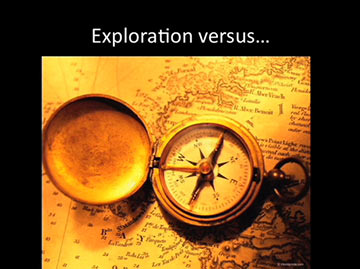FEBRUARY 2, 2010
Professor Toto, we're not in Kansas anymore!
 It started with this post on a LinkedIn Design Education discussion board:
It started with this post on a LinkedIn Design Education discussion board:
I teach in an urban community college setting and I am struggling with classes of over 180 students (36 per lab, 3-4 per group) and no Teaching Assistants while still falling under the microscope of Key Performance Indicator reviews!
Classes of 180 ?! 36 per lab ?! Yikes!
At Tri-C in Visual Communication & Design we limit our lab classes to 17, or whatever number of computers there are in the room. For lecture classes the number is 20-22. How can Jim Kinney, Professor of Graphic Design at George Brown College, do it?
His answer:
I have attempted to adapt to this by deputizing my students with responsibilities for outcomes in teaching...sort of turning the teacher/learner relationship on its head. I too teach in a high tech environment that adds fuel to the fire. The constant cycle of obsolescence compounds the challenge of delivering quality learning experiences...
I worked with my students on building a teaching and learning resource that they could utilize in order to teach and learn peer-to-peer. It can be found at: www.baandd.ca/groups/digitalapplications/
Another vision of education
On the website you'll find Jim's lecture Once We Were Teachers which I highly recommend for anyone struggling to learn and teach and learn design and design technology amidst constant, dizzying change and development.
Just a couple of the things he said in the lecture that struck me:
We're not doing tourism anymore. We're developing explorers.
We're not in a theater with an audience. It's participatory improv.
Either this guy is a new species in the evolution of teachers, or he's a total fraud. You be the judge.
Convergent Education
Another take on the same topic, from eSchoolNews.com:
... schools are still, for the most part, entrenched in teaching in a linear fashion, starting on page one of a textbook, moving through the last page, and then testing to ensure the students have learned the subject. And they’re not allowing students to use many of the very tools–social networks, YouTube, and their mobile devices, to name just a few–that keep kids anchored and learning within their own communities. [read entire article]
Inspired by a colleague I've been moving more and more away from the strictly linear and more towards the learning-community model.
What is our job as teachers?
In case you're wondering, I think that this is the way to go. First, it's simply dealing with the reality of the world we and our students live in. Second, and more importantly, it gets back to our true job as teachers: to teach students how to learn.
You may forget the facts you learned in any course. Technical skills most definitely will become outdated. But if you know how to learn, all the world's knowledge is available to you.
Top |
|
![]()
